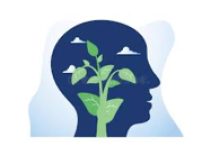
A Lenten series: Sunday afternoons 2/18 -3/17. In person and online
40Then he came to the disciples and found them sleeping; and he said to Peter, ‘So, could you not stay awake with me one hour? 41Stay awake and pray that you may not come into the time of trial; the spirit indeed is willing, but the flesh is weak.’(Matthew 26 vs 40)
The portion of stained glass pictured above is from the Chapel of the Resurrection at St. Georges by the River where this series will be held. In addition ot the scenes from Jesus' post resurrection appearances, there are smaller panels that depict new life emerging from death; the seed becomes a green shoot, a phoenix arises from the flames, a butterfly emerges from a cocoon.
In this holy season of Lent, we are also in a latent state, dormant and yet poised for new vitality. Mindfulness teachings often refer to the ordinary human trait of "autopilot" as the opposite of mindful awareness. We pass through our lives sleepwalking if you will and although auto pilot or cruise control serves a purpose in certain contexts, it can also dull our senses to the Glory of God, which St. Iraneus called "the human being fully alive."
..............................................................................................................................................
Research on mindfulness has shown that, with practice, the brain can be trained to respond, rather than react, to stressful events. In other words, stress is inevitable, but suffering can be reduced! Sitting meditation, body awareness and mindful movement will be taught. This is a gentle practice that requires no previous experience. “Mindfulness” is simply paying attention to present moment experience with open curiosity and a willingness to be with what is.
With great respect and kindness, I invite you to consider making your own mental and spiritual health a priority during these stressful times.
..............................................................................................................................
Rev. Dr. Kathleen Bishop
Vicar, Holy Trinity Church
Spring Lake, New Jersey
Kathleen Bishop received her training in Teaching MBSR (Mindfulness-based Stress Reduction*) at the Jefferson-Myrna Brind Integrative Medicine Center (associated with Jefferson Hospital) in Philadelphia. She also has a private practice of psychotherapy as a licensed Marriage and Family Therapist in Long Branch NJ.
Since completing the teacher training in 2014, she has taught the course many times. This includes an intensive time with Hackensack Meridian Hospital’s Integrative Medicine department from 2016-2018 where she also assisted in developing their online version.
Her Masters of Divinity and Ph.D. are from Drew University. She completed an Ed.D. in Marriage and Family Counseling from The College of New Jersey and is also a licensed Marriage and Family Therapist in NJ.
*MBSR is a distinct approach to mindfulness training developed by Jon Kabat Zinn who, in 1979, founded the Stress Reduction Clinic at the University of Massachussets Medical School. The 8 week course that he created has given rise to thousands of research studies revealing benefits to physical as well as mental health.
Rev. Dr. James Jones
Rutgers University Emeritus Professor
Department of Religion
The Rev. Dr. James Jones is the Priest Associate at St. George’s in Rumson, a NY & NJ Licensed Psychologist, and an Emeritus Professor of Religion at Rutgers University where he taught courses in Contemplative Studies. He has a long-time meditation practice and has written several books and papers on the psychology of religious experience. The most recent (2019 Oxford University Press) is Living Religion: Embodiment, Theology, and the Possibility of a Spiritual Sense.





